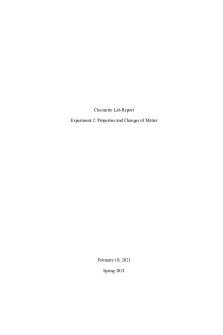Bonding and Properties of Water PDF

| Title | Bonding and Properties of Water |
|---|---|
| Author | Mary Kibbe |
| Course | General Biology I |
| Institution | Manchester Community College (Connecticut) |
| Pages | 4 |
| File Size | 89.1 KB |
| File Type | |
| Total Downloads | 101 |
| Total Views | 161 |
Summary
properties of water lab...
Description
Chemistry of Life: Bonding and Properties of Water
Student Name Mary Kibbe
Date March 1st, 2021
1
Obser Observation vation vations s Activity 1: Solubility Record your observations about the solubility of table salt (sodium chloride) in each solvent from Activity 1. In A1, the sugar coated the bottom of the well. In B1, the sugar completely dissolved. In A2, the salt stuck together on the bottom of the well. In B2, the salt dissolved, and made the isopropanol cloudy looking. In A 3, the benzoic acid sunk to the bottom, in B3, it floats. After stirring, Some of A3 benzoic acid dissolved, but in B3, none of the benzoic acid dissolved. 1. What can you conclude about the polar nature of benzoic acid in Activity 1? We can conclude that Benzoic acid is nonpolar and hydrophobic, which is why it did not dissolve in the water.
2. What type of mixture is benzoic acid and water? What type of mixture is sucrose and isopropanol? Explain your answers. Both the Benzoic acid and water mixture AND the sucrose and isopropanol mixture are suspensions. This is because when the Benzoic acid was added to the water, it separated, and when the sucrose was added to the isopropanol, it also separated, both substances floating to the bottom of the well.
Activity 2: Adhesion and Cohesion Record your observations from Activity 2. Before adding anything to the substance but pepper to C 1,2, and 3, the pepper was floating at the top of the isopropanol. Before adding
© 2016 Carolina Biological Supply Company
2 anything to the substance but pepper to D 1, 2, and 3, the pepper sank to the bottom. When I dipped the stick into C2, nothing much happened, some of the pepper moved around. When I dipped the soap covered stick into C3, some of the pepper stuck onto the soap. When dipping the stick into the D2 section, some of the pepper moved to the bottom of the well and some stuck onto the stick. Some stayed on top. When dipping the stick into the D3 section, the pepper moved away from the stick with the soap. 1. What type of mixture is pepper and water? Explain your answer. Because the pepper and water separate from one another, this would be considered a suspension mixture.
Activity 3: Density and Miscibi Miscibility lity Record your observations from Activity 3. When adding the isopropanol to the water, the mixture became cloudy and hazy. When adding pepper to the mixture, some of it floated on the top but most of it sank to the bottom of the well. After stirring, the water turned brown and all the pepper sank to the bottom of the well. 1. Explain the layers that formed from the two liquids in Activity 3. Water is much denser than isopropanol. When isopropanol was slowly added to the water in D6, the two substances were able to separate and stay separated, forming two layers in that well. When pepper is added to the well, some of it sinks to the bottom and some of it sticks in the top layer.
Activity 4: Hea Heatt Capacity Record your observations from Activity 4.
© 2016 Carolina Biological Supply Company
3 When I touched the stick to the bottom of the cup, the cup did not burn. Once I lit the rim, the fire slowly began to burn around the rim, stopping exactly at where the surface of the water was, it did not burn past the water.
© 2016 Carolina Biological Supply Company...
Similar Free PDFs

Bonding and Properties of Water
- 4 Pages

Properties of Water Lab
- 8 Pages

Properties of Water Worksheet
- 2 Pages

Properties of Water Lab Report
- 2 Pages

Worksheet 1Structure And Bonding
- 7 Pages

Properties and Changes of Matter
- 18 Pages
Popular Institutions
- Tinajero National High School - Annex
- Politeknik Caltex Riau
- Yokohama City University
- SGT University
- University of Al-Qadisiyah
- Divine Word College of Vigan
- Techniek College Rotterdam
- Universidade de Santiago
- Universiti Teknologi MARA Cawangan Johor Kampus Pasir Gudang
- Poltekkes Kemenkes Yogyakarta
- Baguio City National High School
- Colegio san marcos
- preparatoria uno
- Centro de Bachillerato Tecnológico Industrial y de Servicios No. 107
- Dalian Maritime University
- Quang Trung Secondary School
- Colegio Tecnológico en Informática
- Corporación Regional de Educación Superior
- Grupo CEDVA
- Dar Al Uloom University
- Centro de Estudios Preuniversitarios de la Universidad Nacional de Ingeniería
- 上智大学
- Aakash International School, Nuna Majara
- San Felipe Neri Catholic School
- Kang Chiao International School - New Taipei City
- Misamis Occidental National High School
- Institución Educativa Escuela Normal Juan Ladrilleros
- Kolehiyo ng Pantukan
- Batanes State College
- Instituto Continental
- Sekolah Menengah Kejuruan Kesehatan Kaltara (Tarakan)
- Colegio de La Inmaculada Concepcion - Cebu









